30.08.2005
S.Klimov. Portrait of a chessplayer - Peter LEKO, part I
A hero of this article is one of the world's strongest players, who recently was a classical world championship challenger - Peter Leko. There is no need to introduce him especially, however, let's say a few words about his sports biography.
Peter Leko's chess career started off very brightly - he was one of the child-prodigies of a new wave, got a GM title at the age of 14 (which was quite an achievement for the first part of 1990s) and crossed a 2600 sign at 16 (1995), not mentioning his numerous wins in junior events.
I selected one game of that period.
P.Leko (2465) - I.Smirin (2590) B82
Wijk aan Zee 1993
1.e4 c5 2.¤f3 d6 3.d4 cxd4 4.¤xd4 ¤f6 5.¤c3 a6 6.Ґe3 e6 7.f4 b5 8.Јf3. The f4 and Јf3 setup was popular in 80s-90s, but then justly, in my opinion, disappeared from practice. It is especially ineffective with the current move order, when Black has time to play b5-b4.
8...Ґb7 9.Ґd3 b4 10.¤ce2 ¤bd7 11.g4 e5 12.¤b3 exf4 13.Ґxf4. Leko improves his play against Adorjan in 1991: 13.Јxf4 ¤e5 14.g5 ¤h5 15.Јf1 Ґe7 16.¦g1 0-0 17.0-0-0 a5 18.Јh3 g6 19.¤bd4 ¤xd3+ 20.cxd3 d5ѓ with Black's initiative.
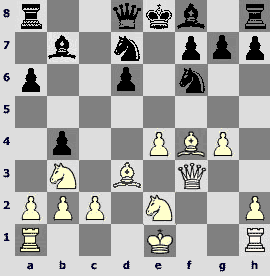
13...Јe7. In order to capture on e5 with the queen after ¤e5. One of the recent examples of this variation: 13...h5 14.g5 ¤g4 15.g6!? fxg6 16.0-0-0 ¤ge5 17.Јg2 Ґe7 18.¤ed4 Ґf6 19.¤e6 Јb6 20.¦he1 ўf7 21.Ґe3 Јc6 22.¤a5 Јc8 23.¤f4 g5 24.¤e2 ¤xd3+ 25.¦xd3 ¤c5 26.Ґxc5 dxc5 27.¦ed1 ¦d8 28.¦xd8 Ґxd8 29.¦xd8 Јxd8 30.¤xb7 Јe7 31.e5І (Berg-Dominguez, Bled 2002).
14.0-0-0 ¤e5 15.Јg3. Leko is ready to part with either e4 or g4 pawns at any time.
15...¦c8 16.¤ed4 Јc7 17.ўb1 g6 18.¦de1 ¤fxg4 19.Ґd2 Јb6 20.¦hf1 Ґg7 21.h3 ¤f6 22.¤f5 Ґf8 23.Јh4 ¤fd7 24.¤h6
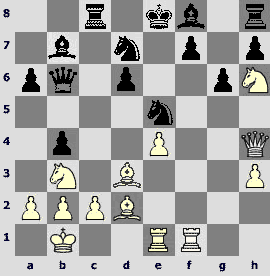
Black appeared in a rather annoying situation - he is a pawn up, there are no threats, but he must castle in order to make progress, and castling is impossible. In the forthcoming play Leko displays qualities that are characteristic for his matured style - he does not attack, but improves his pieces and prevents opponent's intentions, and at the right moment delivers a tactical blow.
24...Ґg7 25.Јf4 ¤c5 26.¤xc5 dxc5 [26...Јxc5!? 27.¤g4 0-0 28.¤f6+ (Leko) 28...Ґxf6 29.Јxf6 ¤xd3 30.Ґh6 (30.cxd3 Јc2+ 31.ўa1 Јxd2) 30...Јxc2+ 31.ўa1 Јxb2+] 27.Ґc4 f6 28.Ґd5 ¦d8 [28...g5 29.Јf5 Ґxh6 30.Ґxb7 Јxb7 31.Јe6+ќ] 29.Ґxb7 Јxb7 30.h4 Јe7 31.Ґc1 ўd7?! Leko 'stands', while Black attempts to move (to transfer king to the queenside) and makes a wrong step. 31...Јe6.
32.¤g4 ¤xg4 33.Јxg4+ Јe6 34.Јg1 ўc6 35.h5. A tempo for this move was gained by previous move attack on c5.
35...¦dg8 36.hxg6 Ґf8
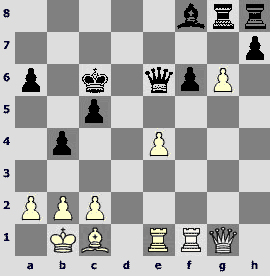
37.e5 ¦xg6 [37...fxe5 38.Јh1+ ўc7 (38...ўb6 39.gxh7 ¦g7 40.¦xf8ќ) 39.¦f7+] 38.Јh1+ Јd5 39.Јh3 f5 40.Јxf5 Ґg7 41.¦d1 Јxe5 42.Јd7+ ўb6 43.¦f7 Ґh6 44.¦e7 [44.Јb7+ ўa5 45.¦d5 ¦g1! (Leko) 46.a3!!ќ (Fritz)] 44...Јb8 45.¦e6+ 1-0
Since 1994 he participates in supertournaments on a regular basis. This fact tells not only about Peter's serious sponsors, but also his sporting abilities - many people were allowed to take part in supertournaments, but only few managed to avoid or minimize setbacks. It is well-known that any invitations to a top level competition tend to disappear after a couple of poor performances. Owing to his very solid style of play, Leko avoided losing streaks, established himself among the elite players and advanced to 2700 (in 1999).
The Hungarian played very well in tournaments with mixed line-up during that period, defeating weaker opponents with classical clarity.
P.Leko (2635) - J.Pinter (2590) С92
Budapest 1997
1.e4 e5 2.¤f3 ¤c6 3.Ґb5 a6 4.Ґa4 ¤f6 5.0-0 Ґe7 6.¦e1 b5 7.Ґb3 d6 8.c3 0-0 9.h3 ¤d7 10.d4 Ґf6 11.a4 ¤a5 [11...Ґb7] 12.Ґc2 Ґb7. Black's move order requires a lot of precision. Less demanding is 12...¤b6.
13.d5
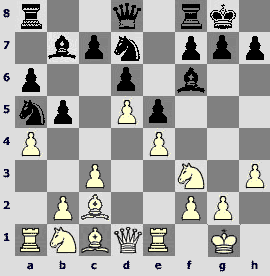
13...Ґe7?! In this situation the move aimed at protecting the d6-pawn and preparing c7-c6 is dubious in view of White's reply. The most interesting alternative is 13...¤b6 14.b4 ¤ac4 15.a5 ¤d7 16.Ґb3 Ґe7, and White's greed 17.Ґxc4 bxc4 18.¤fd2 was not rewarded in the game Jaracz-Onischuk (Koszalin 1999): 18...f5 19.¤a3 ¤f6 20.f3 ¤h5 21.¤f1 fxe4 22.fxe4 Ґh4 23.¦e2 Јf6 and Black's initiative compensates his material deficit.
14.¤a3 c6. I think it was necessary to play 14...f5 15.b4 ¤c4 16.¤xc4 bxc4 17.¤d2 fxe4 18.¤xc4 ¤f6 19.Ґxe4 ¤xe4 20.¦xe4 Ґc8, in order to pretend creating a kingside counterplay with help of his light-squared bishop.
15.b4 ¤c4 16.¤xc4 bxc4 17.dxc6 Ґxc6 18.¤d2 d5 19.exd5 Ґxd5 20.¤f3! Forcing his opponent to exchange a very important bishop, Leko subsequently establishes domination on light squares.
20...Ґxf3. There is no compensation for a pawn after 20...Ґb7 21.¤xe5 ¤xe5 22.Јxd8 ¦axd8 23.¦xe5 Ґf6 24.¦e3± S.Khmelnitsky - Sarvat, Cairo1998.
21.Јxf3. White has various threats (on h7, d7, c4).
21...Јc7 22.a5!
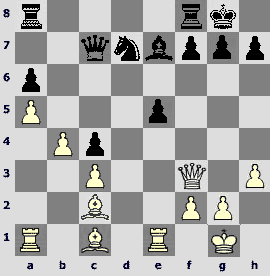
After this move Black's position becomes extremely difficult in strategic sense, as the weakness on a6 is now fixed. He could not remove the pawn from a6 before, because he did not have time for it...
22...ўh8 23.Ґa4 ¦ac8 24.Јd5 ¦cd8 25.Јc6. Naturally, transposing to an endgame in this case is the simplest way of exploiting White's positional advantage.
25...Јxc6 26.Ґxc6 ¤b8 27.Ґf3 f5. The endgame with three weaknesses (a6, c4 and e5) and the opponent having two bishops advantage is practically hopeless for Black. Moreover, he also has to watch for the b5 break. With his last move Pinter gives up a pawn, but attacks on c3.
28.¦xe5 Ґf6 29.¦xf5 ¦fe8 (the immediate 29...Ґxc3 is bad: 30.¦xf8+ ¦xf8 31.¦b1ќ ¤d7 32.Ґb7)
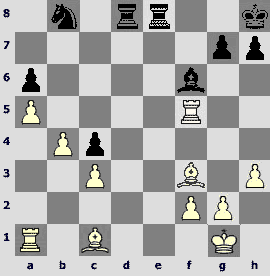
30.¦xf6! At cost of an exchange White liquidates the opponent's counterplay. Two bishops and two pawns give him an obvious edge against rook and knight.
30...¦e1+. For better or for worse, but Black should have abstained from check: 30...gxf6 31.Ґe3 ¦d6, more or less defending against b5.
31.ўh2 gxf6 32.Ґg5! ¦e6 33.¦e1! ¦dd6 34.¦xe6 ¦xe6 35.Ґf4 ¤d7 36.Ґd5. White wins another pawn.
36...¦e2

37.Ґxc4! A fine "small combination".
37...¦e4 38.Ґd3 ¦xf4 39.ўg3 ¤e5 40.ўxf4 ¤xd3+ 41.ўe4 ¤b2 42.ўd5. Black resigned - one of White pawns inevitably queens. 1-0
P.Leko (2600) - A.Rodriguez (2555)
Yopal 1997
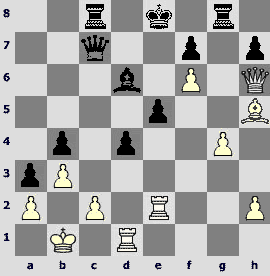
Black threatens with Јc3 - in his opinion, it secures sufficient counterplay...
28.c4!! And White destroys a core of this threat. Immediate 28.Јxh7 led to a perpetual check after 28...Јc3! 29.¦xe5+ (29.Јxg8+ ўd7 30.Јxf7+ ўd8; 29.Јxf7+ ўd8 30.Јxg8+ ўd7) 29...ўd7 30.Јxf7+ ўc6 31.Јd5+ ўc7 32.Јa5+ ўd7 33.Јa7+ ўc6=. There is no win for White in 28.¦xd4 Јc3 29.¦xe5+ ўd8 (29...Ґxe5 30.Ґxf7+ ўxf7 31.Јxh7+ ўxf6 32.Јf5+ ўg7 33.¦d7+; 29...ўd7 30.¦e7+ ўc6 31.¦c4+) 30.¦xd6+ ўc7 31.¦e7+ ўxd6 32.Јf4+ ўc6 (32...ўc5 33.Јe5+) 33.Јe4+ (not 33.Јc1 ¦cd8 34.¦e4 ¦d1 35.¦c4+ Јxc4 36.bxc4 ¦xc1+ 37.ўxc1 ўc5 - White does not risk winning) 33...ўd6 34.Јf4+=. Thus, Leko's solution is not just strong and beautiful, but also the only one!
28...bxc3 29.ўc2! The pawns are blocked, white king is secure, and Black is helpless against the capture on h7 followed by advance of the g-pawn.
29...ўd8 30.Јxh7ќ ¦f8 31.g5 ¦b8 32.Ґg4 Јc6 33.h4 ¦b4 34.h5 d3+
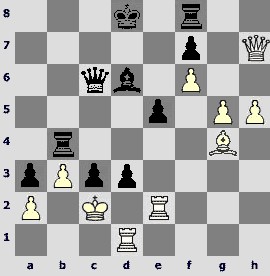
White easily parries counterplay attempts.
35.Јxd3 ¦d4 (or 35...¦xg4 36.Јxd6+ Јxd6 37.¦xd6+ ўc7 38.¦d5 ¦xg5 39.¦dxe5ќ) 36.Јf5 ¦d2+ 37.¦exd2 cxd2+ 38.ўxd2 ўc7 39.Ґf3 Ґb4+ 40.ўe2 e4 41.Ґxe4 1-0
Still, Peter was not considered a real world championship challenger that time.
Regardless of the final result (Leko could not win a supertournament until Dortmund-1999, with average score between -1 and +1), the Hungarian, with all due respect, did not show brilliant play, defeating the tailenders and mostly making draws against the top players.
P.Leko (2745) - G.Kasparov (2849)
Linares 2001
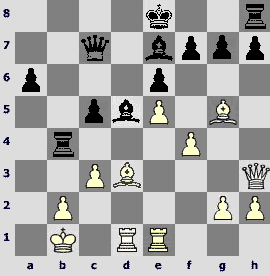
Black's position is probably slightly worse. With his next move Kasparov tries to complicate things with an exchange sacrifice - a typical decision for the 13th world champion.
20...¦b3!? [20...¦b6 21.c4І] 21.Ґc2 Јb7 22.Ґxb3 Јxb3
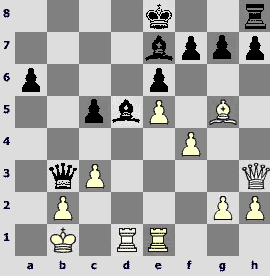
23.¦xd5?! Leko chooses a safe and rational move. After 23.Ґxe7 the variations seem to favor him, but what if I've missed something? 23...Јa2+ (23...Ґe4+ 24.¦d3! Ґg6 25.ўc1! ўxe7 26.Јh4+ f6 27.exf6+ gxf6 28.¦d2 Јa2 29.ўd1±; 23...ўxe7 24.Јh4+ ўd7 25.ўc1 Јa2 26.¦e2± … 26...¦b8? 27.Јxh7 Јa1+ 28.Јb1!) 24.ўc1 Јa1+ 25.ўc2 Јa4+ 26.ўd3 Јc4+ (26...ўxe7 27.Јh4+ ўd7 28.ўe3±) 27.ўd2 Јxf4+ 28.Јe3 Јxe3+ 29.ўxe3 ўxe7 30.c4!± Ґxc4 31.¦c1 Ґd5 32.¦xc5±.
23...Јxd5 24.Ґxe7 ўxe7 25.Јh4+ ўd7 26.Јg4 ўc6!
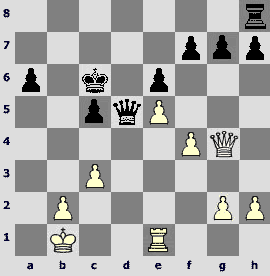
27.Јe2! Simultaneously attacking the a6-pawn and threatening to play ¦d1. The immediate rook move was ineffective in view of Јe4+. 27.Јxg7?! ¦b8„.
27...¦d8 28.Јxa6+ ўc7 29.Јa7+ ўc6 30.Јa6+ ўc7. Black's activity is sufficient for a draw, despite his minus pawn.
31.Јa5+ ўb7 32.Јb5+ ўc7 33.Јa5+ ўb7 34.Јb5+ ўc7 35.Јe2
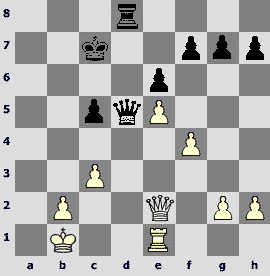
35...h5! 36.g3 g6 37.c4 Јd2 38.Јe3 ¦d4 39.Јxd2 ¦xd2 40.¦e3 ¦xh2 41.¦f3 ўc6 42.ўa2 ¦h3 43.¦b3 h4 44.gxh4 ¦xh4 45.¦f3 ¦h5 46.¦g3 ¦h2 47.¦f3 ¦c2 48.ўb3 ¦c1 49.¦f2 ўb6 50.¦f3 ўa5 51.¦f2 ¦e1 52.ўa3 ¦a1+ 53.ўb3 ¦c1 54.¦f3 ўb6 55.¦f2 Ѕ-Ѕ
Still, one could judge about a real strength of Leko by, for example, his match victory over the FIDE champion Alexander Khalifman. Peter won all three games with White and drew the rest.
P.Leko (2701) - A.Khalifman (2628) В42
Budapest 2000, the 2nd game
1.e4 c5 2.¤f3 e6 3.d4 cxd4 4.¤xd4 5.Ґd3 ¤c6. A solid line - Black forces his opponent to take on c6, and obtains a slightly worse play in a symmetrical position.
6.¤xc6 dxc6 7.¤d2 e5 8.¤c4 ¤f6 9.0-0 Јc7 10.Ґd2 [10.a4!?] 10...Ґg4. Normunds Miesis, who is a well-known Paulsen specialist, here preferred to play 10...b5 a few times, and not without success: 11.Ґa5 (11.¤e3 Ґc5=) 11...Јb8 12.¤b6 ¦a7 13.¤xc8 Јxc8 14.a4 ¦d7. Probably it is more precise, because although Black allows his light-squared bishop being exchanged in both cases, after 10...b5 White has to spend more time for it.
11.Јe1 b5 12.¤e3 Ґc5 [or 12...Ґe6 13.a4І] 13.¤xg4 ¤xg4 14.Јe2 ¤f6 15.b4 Ґb6 16.c4!
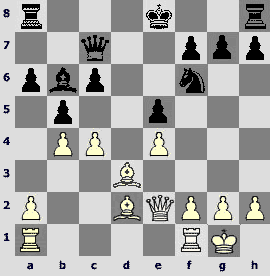
Sooner or later Black's queenside has to be bothered. A weakness of the d4 square is not of much importance here, as White can simply ignore the opponent's bishop located on this square.
16...Ґd4 17.¦ac1 Јd6 18.Ґc2! The bishop moves to a more active position (b3, then, after the a-pawn is exchanged, to a4), and the rooks double on the c-file.
18...0-0 19.Ґb3 ¦fd8 20.¦c2 ¦d7 21.¦fc1 ¦c7 22.g3 h6 23.ўg2 ¦ac8 24.a4 Јe6. Dangerous is 24...bxa4 25.c5 (but not 25.Ґxa4 c5 26.b5 axb5 27.cxb5 ¦a7 28.Ґb3 ¦ca8 with a strong counterplay) 25...Јd7 26.Ґxa4 - it is difficult to defend the weakness on a6.
25.axb5. Less promising is 25.Јd3 bxa4 26.Ґxa4 c5 27.b5 - the b-pawn can be easily blocked.
25...axb5 26.Јd3 bxc4 27.¦xc4 Јd7. So, Black is left with the only weakness - in principle, his position must be defendable.
28.Ґe3. After this move the white pawn b4, as well as the black one on c6, remains unprotected by minor pieces. However, White's progress without this exchange is questionable. 28.Ґa4!?

28...Ґxe3. Better is 28...c5!? 29.Јc2 (29.bxc5 Ґxc5 30.Јxd7 ¤xd7 31.Ґa4 ¤b6 32.¦xc5 ¦xc5 33.¦xc5 ¦xc5 34.Ґxc5 ¤xa4=) 29...Ґxe3 30.fxe3 ¦d8, and Black's counterplay should suffice for a draw, e.g.:
a) 31.bxc5 ¤g4 32.¦e1 (32.¦c3 ¦xc5) 32...Јd2+ 33.Јxd2 ¦xd2+ 34.ўg1 ¦a7 (34...¤xh2? 35.Ґd1ќ) 35.c6 ¤xh2 36.Ґd1 ¦a1= and a draw by perpetual;
b) 31.h3 (not allowing the knight on g4) 31...Јd3 32.Јxd3 (32.bxc5 Јxe3µ; 32.ўf3 Јxc2 33.¦1xc2 ¦b7=) 32...¦xd3 33.Ґc2 ¦d2+ 34.ўf3 ¤d7=;
с) 31.¦xc5 31...¦b7 32.b5 ¦xb5 33.Ґxf7+ (the only way of seeking the advantage, the bishop can not be taken because then the rook on b5 is lost.
29.Јxe3 Јe7. Leko's assessment of the subsequent complications was more accurate. Better was 29...Јd6 30.Ґa4 ¤d7 31.Јc3 ¤b8 (passive but solid) 32.b5 [or 32.¦c5 ¤a6 (32...f6 33.b5±) 33.¦d1 Јf6 34.¦xe5 ¤xb4І - White is better, but Black can survive] 32...c5 33.¦d1 Јf6 [worse is 33...Јe7 34.b6 (34.¦d5 ¤d7) 34...¦b7 35.¦d5 ¦xb6 36.¦xe5 Јb7 37.¦cxc5±] 34.b6 (otherwise ¤d7-b6) 34...Јxb6 35.Јxe5 Јa6І - Black's position is worse, but as the remaining material is scarce, there is a hope to make a draw by giving up the c5-pawn somewhere.
30.Ґa4 ¦b8 31.Јc3 ¦cb7 32.¦b1 c5
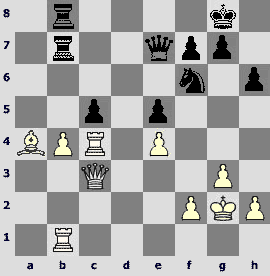
33.¦xc5! ¤xe4 34.¦c8+ ўh7 35.Ґc2 f5 36.Јf3!±. It seems Black missed this move in his calculations.
36...¦xc8 37.Јxf5+ g6 38.Јxc8 ¤f6 39.Јc3 ¦b6 40.Јc5!
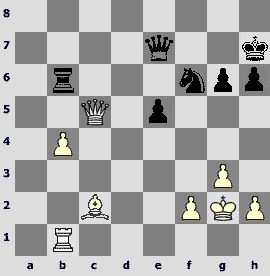
The endgame with an extra passed pawn is won for White.
40...Јxc5 41.bxc5 ¦xb1 42.Ґxb1 ўg7 43.ўf3 ўf7 44.c6 ¤e8 45.ўe3 ¤f6 46.Ґe4 ¤e8 47.ўd3 ¤c7 48.ўc4 g5 49.Ґf5 h5 50.ўc5 ўe7 51.f3 h4 52.Ґd7 1-0
Leko's career went uphill in 2002. He became an official world championship challenger (Kasparov-Kramnik version) in a fantastically tense candidates tournament in Dortmund, defeating Veselin Topalov in the final.
Peter confirmed his new status in a number of competitions. He drew the match with Kramnik and won a tournament in Wijk aan Zee in 2005.
So, what are the strengths of Peter Leko?
The most important quality of the Hungarian in a sporting sense is a great psychological stability, his ability to withstand a pressure, fight "until bitter end", as long as it is needed to succeed. Even the strongest opponents sometimes can't keep up with him and commit fatal mistakes.
P.Leko (2736) - V.Anand (2753) С42
Linares 2003
1.e4 e5 2.¤f3 ¤f6 3.¤xe5 d6 4.¤f3 ¤xe4 5.d4 d5 6.Ґd3 ¤c6 7.0-0 Ґe7 8.c4 ¤b4 9.Ґe2 0-0 10.¤c3 Ґf5 11.a3 ¤xc3 12.bxc3 ¤c6 13.¦e1 ¦e8 14.cxd5 Јxd5 15.Ґf4 ¦ac8
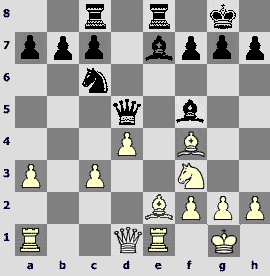
Tabia of the new century. In the beginning White played here 16.c4 Јe4 17.Ґe3, then Kramnik invented 16.h3 with idea to play ¤h2-g4 (by the way, Leko himself played it against Kramnik in the first game of their match), and, finally, White has successfully tested two new moves during the recent supertournament in Sofia: 16.Ґg3 and 16.Јc1. Leko's text-move - 16.Ґd3 - does not claim a large advantage - in the Petroff White does not voluntarily exchange minor pieces. On the other hand, Black's position is nevertheless a little bit worse.
16.Ґd3 Јd7 17.¦b1 [17.Ґb5 Ґd6 18.¦xe8+ ¦xe8 19.Ґxd6 Јxd6 20.d5 ¦d8=] 17...Ґxd3 18.Јxd3 b6 19.d5 For some time Anand demonstrates what is likely the most precise reaction to White's actions - he neutralizes the ¤g5 idea and makes sure the c6-knight retreats to good squares.
19...Ґf6! [19...Ґxa3 20.¤g5! g6 21.¤e4 Ґe7 22.¦bd1 ¤a5 23.Ґh6] 20.c4 h6 21.h3 ¦e7! 22.¦bd1 ¦d8 [22...¦ce8 23.¦xe7 ¤xe7 24.¦e1І] 23.¦xe7 ¤xe7 24.¤e5 Ґxe5 25.Ґxe5 ¦e8 26.Ґg3

26...¤f5?! Undermining 26...c6 and keeping a status quo 26...¤c8 seem to be better than the text, which allows White to create a passed pawn and advance it to d7. Maybe Anand considered the resulting position to be a technical draw?
27.Ґxc7 Јxc7 28.Јxf5 Јxc4 29.d6 ¦d8 30.d7 Јc6 31.g3 [31.Јe5 ўf8І] 31...a6 32.h4 b5 33.¦d5 a5. Inviting White into a rook ending with an extra pawn, which is considered (sort of) drawn.
34.¦xb5 g6! 35.Јd5 Јxd7 36.Јxd7 ¦xd7 37.¦xa5
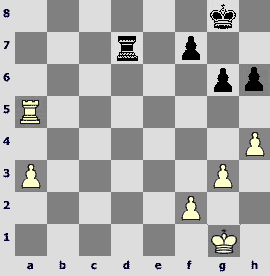
37...ўg7. Any Soviet candidate master knows that in such positions one must play h6-h5, but Anand stubbornly refuses to play it - and it is foolish to suspect him of being illiterate! Probably the reason is that the evaluation of this standard endgame with such pawn chains was somewhat shaken recently - Mark Dvoretsky found that when the pawn stands on a5, White can win a few tempi speculating of a "bridge" motif ¦c4-a4 (one can get acquainted with his findings on our site). Obviously, Anand knew it and tried to find an alternative defense system. I will not go deep into analysis of this endgame, but only show where Anand could have played stronger according to annotators.
38.a4 ¦d1+?! [38...¦d4] 39.ўg2 ¦a1 40.g4 ўf6 41.ўg3 ¦c1 42.¦b5 g5? [№ 42...¦c4 43.a5 ¦a4] 43.¦f5+ ўg6 44.h5+± ўg7 45.a5 ¦a1?! [45...¦c4] 46.ўg2
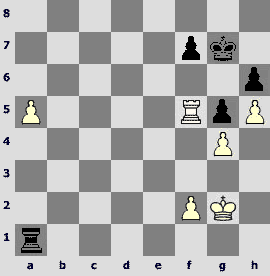
The rook now defends all pawns, the king is free to go, and Black's position is hopeless.
46...¦e1 [46...¦a4 47.f3 ¦a2+ 48.ўf1] 47.f3 ¦e6 48.ўf2 ўf8 49.¦b5 ўg7 50.¦f5 ўf8 51.¦c5 ўg7 52.¦b5 ўf8
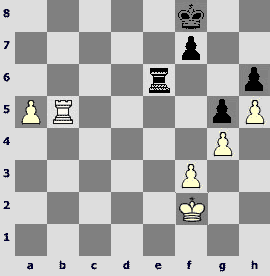
53.¦b6! ¦e5 54.a6 ўg7 55.a7 ¦a5 56.¦b7 ¦a3 57.ўe2 ўf6 58.ўd2 ўe6 59.ўc2 f6 60.ўb2 ¦a4 61.ўb3 ¦a1 62.ўb4 ўd6 63.¦h7 ўe5 64.ўb5 ¦a2 65.ўb6 ўd5 1-0. Black resigned, in view of ¦h8.
This was Leko's first victory against Anand in classical chess - and they have been playing in the same tournaments for almost 10 years! The style of this win strongly resembles Karpov's. Balancing on an edge of a draw, Leko found a position highly unpleasant (subjectively unpleasant, which is also very important) for the opponent. Still, if all the players are divided into two categories - creators and destructors, Leko certainly falls into the latter one. He forces his opponents making mistakes, calculates precisely, refutes their ideas, prevents their counterplay - but he struggles finding own original concepts.
A course of the championship match against Kramnik in 2004 is very illustrative. Yet before it started, chess pundits reasonably suspected that all games can be drawn, and in any case a single win will literally decide the outcome.
After losing the very first game, Leko displayed a great sporting-psychological mastery, taking a full point in a position, in which one could think Kramnik is able make a draw "by hand".
P.Leko (2741) - V.Kramnik (2770) D37
Brissago 2004, the 5th game
1.d4! ¤f6 2.c4 e6 3.¤f3 d5 4.¤c3 Ґe7 5.Ґf4 0-0 6.e3 c5 7.dxc5 Ґxc5 8.cxd5 ¤xd5 9.¤xd5 exd5 10.a3 ¤c6 11.Ґd3 Ґb6 12.0-0 Ґg4 13.h3 Ґh5 14.b4 ¦e8 15.¦c1 a6 16.Ґxa6 ¦xa6 17.b5 ¦xa3 18.bxc6 bxc6 19.¦xc6 ¦a7 20.¦d6 ¦d7 21.Јxd5 ¦xd6 22.Јxd6 Јxd6 23.Ґxd6
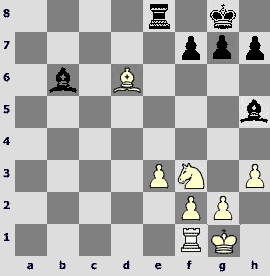
This is all theory. In this position Anand made a draw against Karpov in 2002. Curiously, both players had no objective reasons to avoid this endgame. From Leko's side, it is always useful to torture your opponent for 100 moves in a match, and from Kramnik's - why he should avoid a draw with Black? It is another story that Kramnik did not consider his poor form, which prevented the champion from showing his usual technical excellence.
23...Ґxf3 24.gxf3 Ґd8 25.¦b1 Ґf6 26.ўg2 g6 27.f4 ўg7 28.¦b7 ¦e6 29.¦d7 ¦e8 30.¦a7 ¦e6 31.Ґc5 ¦c6 32.¦a5 Ґc3 33.¦b5 ¦a6 [33...¦c8] 34.¦b3! Ґf6 35.¦b8!
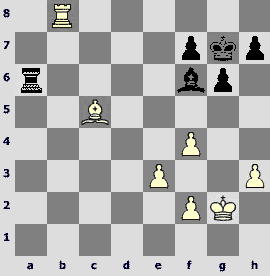
Forces Black to soften his pawn chain.
35...h5 [35...Ґc3 36.Ґf8+ ўf6 37.e4±] 36.¦b5 Ґc3 [36...¦a8] 37.¦b3 Ґf6 38.e4 ¦a5 39.Ґe3 ¦a4 40.e5 Ґe7 41.¦b7 ўf8 42.¦b8+ ўg7 43.ўf3 ¦c4 44.ўe2 ¦a4 45.ўd3 Ґh4
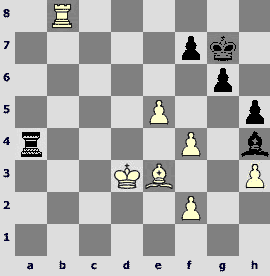
46.Ґd4! ¦a3+ 47.ўc2 ¦a2+ 48.ўd3 ¦a3+ 49.ўc4 ¦a4+ 50.ўd5 ¦a5+ 51.ўc6 ¦a4 52.ўc5 Ґe7+ 53.ўd5 ¦a5+ 54.ўe4 ¦a4 55.¦c8 Ґh4 56.e6+ Ґf6
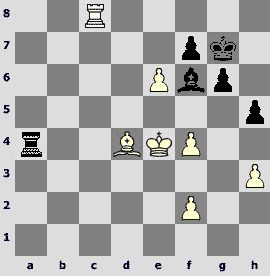
57.e7! ¦xd4+ 58.ўe3 Ґxe7 59.ўxd4 Ґh4 [59...f5] 60.f3 f5 61.¦c7+ ўf6 62.ўd5 Ґg3 [62...Ґe1! 63.¦c6+ ўf7 64.ўe5 Ґa5! 65.¦f6+ (65.¦c8 Ґb6) 65...ўg7 66.ўe6 Ґc3! (66...Ґd8 67.¦f7+ ўg8 68.¦d7 Ґh4) 67.¦f7+ ўg8 68.¦d7 Ґb2= (P.Lukacs)] 63.¦c6++- ўg7 64.ўe5 h4 [64...Ґh4 65.ўe6+- ўg8 66.¦c8+ ўg7 67.¦b8 with Zugzwang (S.Shipov)] 65.¦c7+ ўh6 66.¦c4! ўg7 67.ўe6 Ґh2 68.¦c7+ ўh6 69.ўf7 1-0
This game is hardly a great creative achievement of the Hungarian, but the result is positive!
By the way, extreme technical perfectionism distinguishes him even from other elite players.
R.Ponomariov (2734) - P.Leko (2736)
Linares 2003
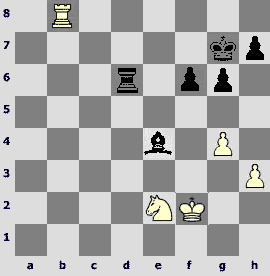
This position appeared after the Black's 36th move. The game lasted for a total of 110 moves! First Leko fixed the h3-pawn by h5-h4, then brought his king to d4, prepared and executed f6-f5 and missed a victory when there was just one step to go.
The most important chess strength of Leko is in my opinion great clarity of style, and ability to outplay very strong opponents positionally, finishing with a small combination. Capablanca was famous for it too. Among modern chess elite, Adams and Anand play in a similar manner. Such a style makes a strong impression. A position seems to be completely unclear, suggesting a rich fight, but after a couple of "simple" positional moves it turns out that there is no counterplay, and exploiting the advantage is just a matter of technique.
P.Leko (2713) - A.Grischuk (2671) С42
Wijk aan Zee 2002
1.e4 e5 2.¤f3 ¤f6 3.¤xe5 d6 4.¤f3 ¤xe4 5.d4 d5 6.Ґd3 ¤c6 7.0-0 Ґe7 8.c4 ¤b4 9.Ґe2 Ґe6. Another variation - 9...Ґf5 - had recently come into fashion.
10.¤c3 0-0 11.¤e5 f6 12.¤f3 ўh8 13.a3 ¤xc3 14.bxc3 ¤c6 15.¤d2
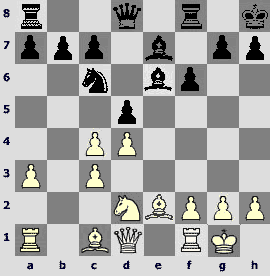
15...f5. One of the recent examples in this line is 15...¤a5 16.cxd5 Ґxd5 17.c4 Ґf7 18.Ґb2 f5 (18...c5!?) 19.Ґc3 c5 20.d5 Ґf6 21.Јc2 b6 22.Ґd3 Ґxc3 23.Јxc3 ¤b7 24.¤f3 - White relocated the knight on e5 and obtained an obvious edge (Kasimdzhanov - Adams, Tripoli 2004).
16.¦e1 Ґf6 17.a4. A little bit mysterious move. If White plans to play c4-c5, like in the game, why should he prepare Ґa3 ? Maybe, the point is to have Ґb5 against Јd7 and ¤a5? It is not easy to find a move that would be in accordance with the c4-c5 plan, too. Previously Leko played 17.Ґf3 Ґg8 18.cxd5 Ґxd5 19.¤b3 b6 20.Ґf4 ¤e7 (20...¦c8!? Galkin - Motylev, Dubai 2001) 21.Ґe5 c6 22.Ґxf6 ¦xf6 23.¤c1 ¤g6 24.¤d3 h6 25.¤e5 ¤h4 26.Ґxd5 Јxd5 27.f3 c5 28.dxc5 - a draw was agreed (Leko - Kramnik, Dortmund 2001).
17...Ґg8. A part of Black's plan: Ґg8, Јd7, ¦ae8. However, it could be better to start with 17...Јd7.
18.c5 ¦e8 19.¤f3 h6. Black prepares g7-g5, trying to prevent Ґf4. However, the game revealed that this move has tactical drawbacks - weakening the kingside. One could defend against Ґf4 by 19...¦e4!? 20.Ґd3 ¦xe1+ 21.Јxe1 Јd7І.
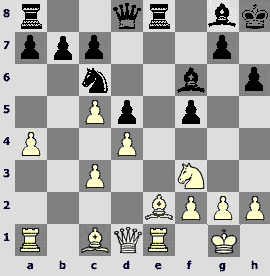
20.¦b1! ¦b8. Black tried to do without weakening the c6-knight. Nevertheless 20...b6 deserved attention: 21.Ґa3 Јd7 22.Јd2 ¤a5 23.Ґb5 c6 24.Ґd3.
21.Ґd3 ¦xe1+ 22.Јxe1 Јd7 23.Ґf4 ¦e8? A mistake in calculations. Black has an accurate 23...Ґh7. Here White has two attempts of conquering the c5-square - either immediately, or after exchanging the c6-knight to light-squared bishop. In the latter case he at least maintains the pressure: 24.Ґb5 [24.¤e5 Ґxe5 25.Ґxe5 ¤xe5 26.Јxe5 ¦e8 27.Јf4 g5 28.Јd2 b6 29.cxb6 (29.Ґb5 c6 30.Ґf1 f4) 29...axb6 30.Ґb5 c6 31.Ґf1 Јd8 32.f4І] 24...¦e8 25.Јd2 a6 26.Ґxc6 Јxc6 27.Ґe5І, and if 27...Ґd8 (obviously, Black does not want to swap the bishops), then 28.a5ѓ. Still, it is easy to advise moving a bishop on h7, but actually playing it is extremely disgusting!
24.Јd2. Black pawns b7 and h6 hang simultaneously. His next move is forced.
24...g5™ [24...b6 25.cxb6 cxb6 26.Ґxh6!ќ] 25.¦xb7! ¦c8 [25...gxf4 26.Јxf4 Јg7 (26...Ґg7 27.¦xc7ќ; 26...¦c8 27.Јxh6+ќ) 27.¦xc7 ¤e7 28.¦xa7±]
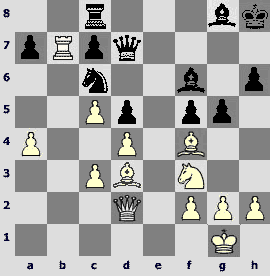
26.h4! Aesthetically impressive move - White literally forces the opponent to capture the bishop. Also noe bad is 26.Ґb5!? gxf4 27.¦xa7 (27.Јxf4 Ґg7 28.¤e5 Ґxe5 29.Јxh6+ Јh7 30.Јxh7+ ўxh7 31.Ґxc6 Ґf4 32.Ґd7 ¦f8 33.¦xa7±) 27...¦e8 (I do not see other way of defending against ¦a6) 28.Јxf4 ¦e6 29.Јxh6+ Јh7 30.Јxh7+ Ґxh7 31.¦xc7±, and White has already 5 pawns for a piece.
26...gxf4 27.Јxf4 Ґg7 28.Јxf5! Јd8 [28...Јxf5 29.Ґxf5 ¦f8 (29...¦e8 30.Ґd7ќ) 30.Ґd7! ¤b8 31.Ґg4±; 28...Јe8 29.Ґb5±] 29.¤g5! hxg5 [29...¤e7?? 30.¤f7+ Ґxf7 31.Јh7#; 29...Јe8 30.¤f7+ Јxf7 31.Јxc8ќ] 30.hxg5. Black has no defense against check on h3, returning a piece, after which White has a powerful initiative and 4 pawns for a knight.
30...Јf8™ 31.Јh3+ Ґh6 32.Ґf5 ¦e8 33.¦xc7 ¦e1+ 34.ўh2 ¤e7 35.g4 Ґe6 36.Јxh6+
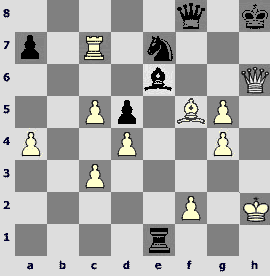
In the endgame White has too many passers.
36...Јxh6+ 37.gxh6 ¤xf5 38.gxf5 Ґxf5 39.¦f7! Forcing the bishop to leave the c8-h3 diagonal.
39...Ґg6 40.¦xa7 ¦c1 41.ўg3. A move that reminds of the maneuver ўg3-h4-g5-f6 in the famous Capablanca - Tartakover game.
41...¦xc3+ 42.ўf4 Ґh5 43.ўe5 ¦f3 44.c6 Ґg4 45.a5 ¦xf2 46.a6 ¦c2 47.¦c7 … a7ќ 1-0. Basically, it feels that White's play is all simple and natural...
P.Leko - P.Svidler В90
Wijk aan Zee 2005
1.e4 c5 2.¤f3 d6 3.d4 cxd4 4.¤xd4 ¤f6 5.¤c3 a6 6.f3 e5 7.¤b3 Ґe6 8.Ґe3 Ґe7 9.Јd2 0-0 10.0-0-0 ¤bd7 11.g4 Јc7 12.ўb1 b5 13.g5 ¤h5 14.¤d5 Ґxd5 15.exd5 ¤b6 16.¦g1 ¦ab8
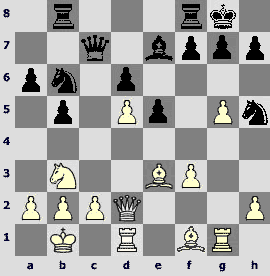
17.¦g4. After 17.Ґxb6 Јxb6 the rook hangs, and White has no time to bring his knight on c6, which is exactly the idea of a whole variation.
17...g6 18.h4. Formally a novelty. In the game Alekseev-Palac (Geneva 2004) White played 18.Ґxb6 Јxb6 19.¤a5 f5 20.gxf6 ¤xf6 21.¦g2 ¤h5 22.¤c6 ¦b7 23.Ґd3 ¤f4 24.¦g4 Ґd8 25.Ґe4 a5 26.c3. However, I do not see a big difference between capturing right here or on the next move.
18...¤g7. 18...¤c4 19.Ґxc4 bxc4 20.Јc3±; interesting is18...¦fc8!? (the knight can be of some use on h5).
19.Ґxb6 [19.¤a5 ¤xd5 20.Јxd5 Јxa5›] 19...Јxb6 20.¤a5. The knight penetrates on c6, and Black has a choice - to suffer (but then one must seek the kingside counterplay by f7-f5, and the knight on g7 is misplaced), or to part with an exchange. Peter Svidler gave up material, but a counterplay did not work out.
20...¦fc8 [20...f5!?] 21.¤c6 ¦xc6 22.dxc6 ¤f5 [22...¤h5 23.f4!? (23.Ґd3 Јxc6 24.Ґe4) 23...¤xf4 24.¦xf4 exf4 25.Ґg2 … Јf4 and Ґd5] 23.¦e4. White prepares to open up the center by f2-f4.
23...Јxc6 24.Ґg2 ¦d8 25.f4 Јc5. It seems 25...Јc7!? is better. On 26.Јe1 there is 26...exf4 27.¦xf4 d5 … d4 and ¤e3.
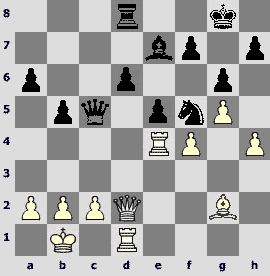
26.Јe1! The bishop on e7 hangs, and Black is at risk of also losing the e5-pawn.
26...¦c8 27.c3 b4. Otherwise he had to play 27...f6 in order to defend on e5, which would open up black king too much.
28.¦xb4 ¤e3 29.¦d2 a5 30.¦e4 ¤c4 31.¦xc4 Јxc4 32.fxe5, and White converted an extra pawn.
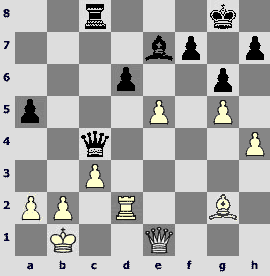
32...Јe6 33.¦e2 d5 34.Јf1 Јa6 35.¦d2 Јc4 36.¦d4 Јxf1+ 37.Ґxf1 ¦d8 38.b4 axb4 39.cxb4 Ґf8 40.Ґg2 ¦e8 41.Ґxd5 ¦xe5 42.a4 ўg7 43.Ґb3 h6 44.gxh6+ ўxh6 45.Ґxf7 g5 46.h5 ¦e7 47.Ґg6 ¦a7 48.b5 Ґc5 49.¦c4 Ґf2 50.ўc2 ¦e7 51.ўb3 ¦e5 52.¦e4 ¦c5 53.ўb4 ¦c1 54.ўa5 ¦g1 55.b6 g4 56.b7 ¦b1 57.¦e2 1-0
Of course, such manner also means a tactical skill - and Leko, as well as other elite players, has it.
V.Anand - P.Leko
Wijk aan Zee 2005
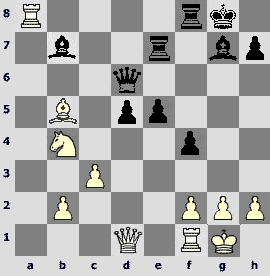
25.¦a7. Anand clearly wants to sacrifice an exchange: 26.¦:b7 ¦:b7 27.Ґc6. Better was 25.¦xf8+, although after 25...Ґxf8 … ¦g7 and d4 Black is not worse.
25...d4! 26.Ґa6? S.Shipov correctly recommends 26.Јh5 Ґf3 27.Јxf3 ¦xa7 28.Ґd3, with sufficient compensation.
26...Ґxg2! 27.Ґc4+. 27.¦xe7 Јg6!, and there is no defense against a discovered check - Anand missed it.
27...ўh8 28.¦a6 Јc5 29.ўxg2 f3+ 30.ўh1 Јxc4µ, and Black got a large advantage.
